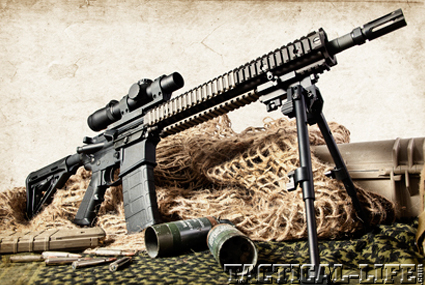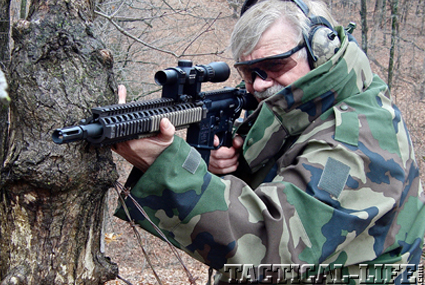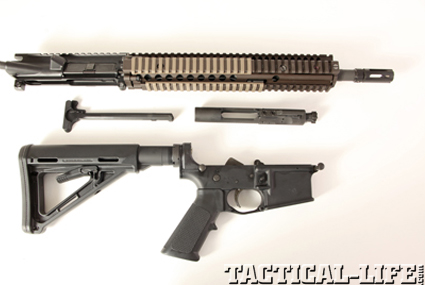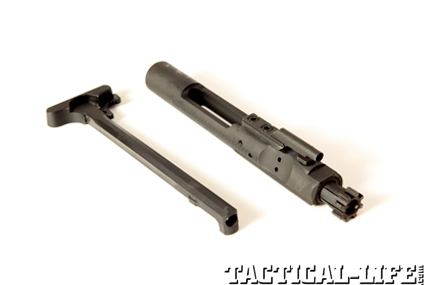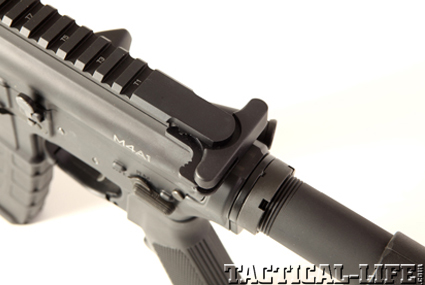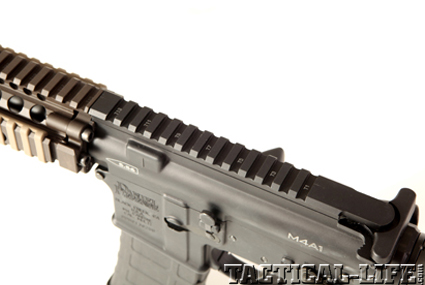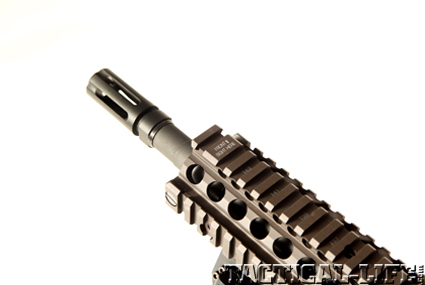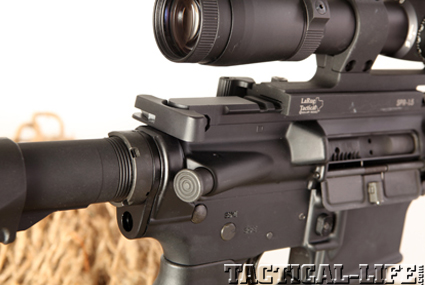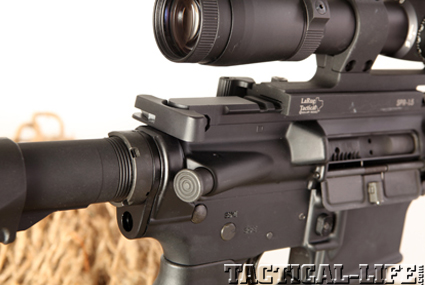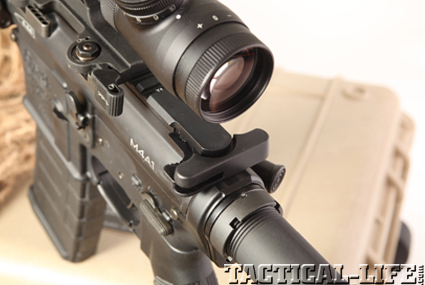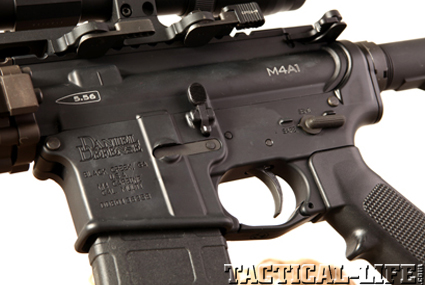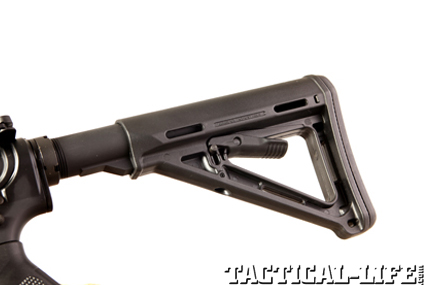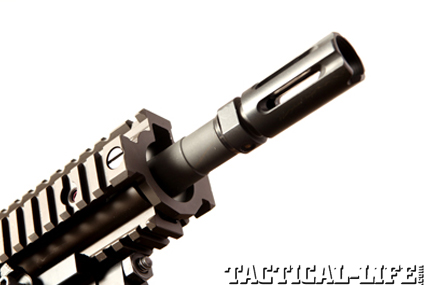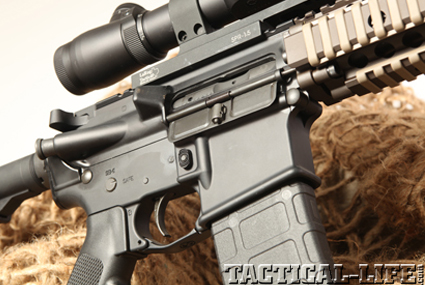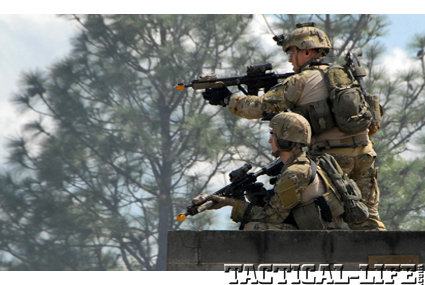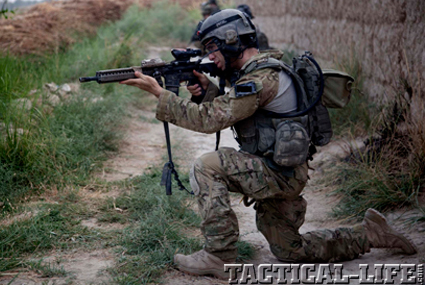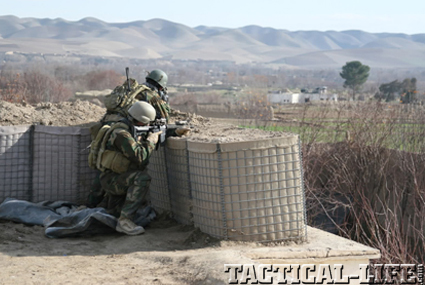It’s hard to believe the M4 Carbine has now been around for almost three decades. Colt was originally awarded a development contract for the XM4 carbine in 1985. The initial intent for the XM4 was the creation of a carbine that would serve the same purposes as the World War II M1 Carbine. That is, provide a weapon to support troops and others who did not need a full-sized M16A2. One of the stipulations in the contract was that as many parts as possible should be common with the M16A2. Another stipulation was that the new carbine would use the M855 (62-grain) round as well as the M193 (55-grain) round. The 14.5-inch barrel would, therefore, have a 1-in-7-inch twist rate. Upper and lower receivers would be the same as those of the M16A2. The XM4 would also incorporate the three-round burst feature of the M16A2.
- RELATED: Gun Review: Daniel Defense’s MK18 5.56mm
- RELATED: Gun Test: Daniel Defense’s M4V4 SBR 5.56mm
Due to the shorter barrel and the gas port being closer to the bolt, Colt engineers felt that the bolt would be under greater stress due to the higher cyclic rate, but to maintain parts interchangeability, there was not a redesign of the bolt or barrel extension. Some changes were, however, necessary. Because of the shape of the M855 round and the higher cyclic rate, the feed ramps on the barrel extension and the upper receiver were extended. It was also necessary to develop a new buffer to counter bolt carrier bounce during burst fire. A tungsten buffer of almost twice the weight of the M16A2’s steel one was developed to help slow down the cyclic rate. A handguard with double heatshields was also developed to allow heat to be dissipated more effectively. A few other parts were modified as well.
The M4 Carbine was initially delivered with the standard M16A2 rear sight, but was soon replaced with the Mil-Std-1913 flattop receiver, which allowed for the mounting of an array of optical sights. Both versions were supplied with the now-familiar telescoping stock.
Advertisement — Continue Reading Below
M4s in Service
On August 15, 1994, after years of development by Colt, the U.S. armed forces adopted the M4 and M4A1 Carbines. The M4 had the three-round-burst setting, while the M4A1 had the full-auto setting. All M4A1s also had Picatinny rails. Most of the M4A1s were supplied to U.S. Special Operations Command (SOCOM). Despite the original contract specification of interchangeability, as adopted, about 25 percent of M4 components are not interchangeable with the M16A2. As a result, the Department of Defense has been very reluctant to adopt improvements requiring new parts that Colt has suggested during production of the M4/M4A1.
Because of its more compact size, the M4A1 quickly became the standard weapon for many SOCOM operators. Because of the large number of rounds shot by some SOCOM units in training (24,000 rounds per year)—especially the U.S. Navy SEALs, who were known to wear out barrels extremely quickly—problems arose with the M4A1. However, Rock Island Arsenal testing determined that the amount of full-auto shooting necessary to cause most of the problems would not occur with normal use. Colt did provide a heavier barrel designed by Rock Island Arsenal and an improved buffer for the M4A1 on later models.
As of July 2009, the U.S. Army acquired ownership of the M4 design from Colt, which will allow for the purchase of the M4 and M4A1 parts from other vendors. The Army has continued to purchase M4A1s from Colt and Remington, with contracts for well over 100,000 carbines. In February 2013, a contract was awarded to FN to produce another 120,000 M4A1 carbines. There have been some snags with the M4/M4A1 in Afghanistan and Iraq, especially with sand and dust. Problems seem to have been most common on M4/M4A1s with accessories mounted. As a result, there have been SOCOM tests of other designs, including those designed with a gas piston system rather than the direct impingement system used on the M4. However, the recent orders for M4A1s are indicative that the M4 will be around for quite awhile yet.
Advertisement — Continue Reading Below
Daniel Defense M4A1
SOCOM does have the leeway to upgrade its M4A1s, and at least one version in use is the Daniel Defense M4A1. To backtrack a bit, though, Daniel Defense is probably best known for supplying its M4A1 Rail Interface System (RIS) II to SOCOM for the SOPMOD (Special Operations Peculiar Modifications) II program. As supplied for the SOPMOD II kit, Daniel Defense Upper Receiver Groups and Rail Interface Systems were supplied for 10.3-, 12.25-, and 14.5-inch barrels. The RIS II allows the M203 grenade launcher to be free-floated without any additional parts or special tools to mount it. This is important, as the accuracy of the M4 will not be adversely affected with the M203 mounted, though the point of aim might have to be adjusted when the launcher is mounted. The RIS II is designed to be used in conjunction with the MK12 Low Profile Gas Block, which is also produced by Daniel Defense.
Among the features of the Daniel Defense RIS II are its free-floating barrel design, uninterrupted upper rail platform, aircraft-grade aluminum, hardened-steel barrel nut, Grade 8 mil-spec fasteners and Picatinny rails. The value of a free-floating barrel, which does not affect barrel harmonics, has already been mentioned. Also important is the uninterrupted top rail on the upper receiver, as SOCOM operators will often mount multiple optics, night-vision devices, etc., in line. The use of aluminum is also desirable, as it keeps the additional weight added by the rails down. Grade 8 mil-spec fasteners are hex-head cap screws that meet various military quality-control specs. To install the RIS II, the standard M4 barrel nut is removed and replaced with Daniel Defense’s proprietary hardened-steel barrel nut.
To give civilian shooters a chance to own and shoot an M4 Carbine as close as possible to those used by SOCOM, Daniel Defense now offers its M4A1 Carbine with the same RIS II rail supplied to SOCOM through Naval Special Warfare Center Crane and a 14.5-inch barrel with a pinned Daniel Defense flash suppressor, which brings the barrel length to a non-NFA 16 inches. This barrel is chrome-lined and magnetic-particle tested, and has a 1-in-7-inch twist rate, which is best for ammunition using heavier bullets and tracer rounds. To optimize the barrel, an erosion-dampening gas port is used. A full-auto bolt carrier is also installed along with a Carpenter 158 steel bolt that is mil-spec magnetic-particle and high-pressure tested. Note that Carpenter 158 refers to the steel used, which has a higher chromium and nickel content than the steel used in some bolts.
Our Test DDM4A1
The version I tested came without backup iron sights. The lower receiver is mil-spec with a flared magazine well. The upper receiver is also mil-spec, with indexing marks and M4 feed ramps. A Daniel Defense Low Profile Gas Block is used. The carbine’s buttstock is a Magpul MOE with a mil-spec receiver extension. One Magpul PMAG was supplied with the carbine. Three Daniel Defense rail ladders were also included. I have found that this is a small but important accessory for carbines supplied with rails, as it allows the user to install the ladders on portions of the rail not needed for accessories to protect the hands.
Advertisement — Continue Reading Below
Most of my M4 Carbines do not have the full-length rail as used on the Daniel Defense M4A1, so I spent a few minutes thinking about the longer quad-rail. I shouldered the carbine from a low-ready position a dozen times or so and found that the balance was really quite good and the carbine felt lively in my hands. Although I don’t normally use a vertical foregrip on semi-auto carbines, the longer rail provides plenty of space to mount one to suit a wider array of operators. Illuminators can also be mounted farther forward.
I have a few optical sights that I like and use when testing M4-type carbines. Since I wanted to shoot the Daniel Defense M4A1 at longer ranges, I did not use one of the red dot types, but instead chose Leupold’s 1.5-4x20mm Mark AR Mod 1 scope. I’ve found this scope an excellent combination of quality, versatility and affordability. It can be set on 1.5X magnification for CQB and 4X for longer-range shooting.
Range Report
For accuracy testing I used Federal 69-grain Sierra MatchKing ammo, which I felt would be maximized by the M4A1’s 1-in-7-inch-twist barrel, as well as Wolf 55-grain FMJs. In all, I fired 40 rounds of the Federal and 120 rounds of the Wolf. There were no malfunctions during the 160 rounds. When I was shooting at plates at 35 and 50 yards to test quick engagement and handling, I found the M4A1 handled very well. I could move easily among four or five hanging plates. Doing so and firing quickly, I definitely appreciated the ladders to protect my support hand. I did not have a chance to mount an illuminator forward on the longer rail to shoot in low light.
My accuracy testing was done at 100 yards from a standing rest. My best three-shot group, measuring 1.25 inches, was produced with Federal’s 69-grain Sierra MatchKing. That’s really quite good in my experience with an M4 Carbine. I’ve done slightly better a few times, getting under an inch, but I’ve done worse more often. My best 100-yard groups have usually been around 0.75 inches, and that was with M4s sporting match triggers. I fired both three- and five-round groups with the 55-grain Wolf ammo at 100 yards. As expected, they were not as good as with the Federal ammo, but they were certainly acceptable.
Advertisement — Continue Reading Below
Overall, I was extremely impressed with the Daniel Defense M4A1, enough so that I’ve asked Daniel Defense to put me on the list for one. It is such a good carbine that I will probably make it a little better by adding a match trigger. When I get the one I ordered, I plan to shoot it in low light to judge how much of an advantage the longer rails are with illuminators and NVDs.
Daniel Defense has a proven record for quality, as attested by the adoption of its products by SOCOM after rigorous testing against other quality rail systems. I think we in the civilian market are lucky that Daniel Defense is making the same products available for us. The M4A1 I tested will be available as an AcuSport distributor exclusive. For more information, call 866-554-4867 or visit danieldefense.com.
